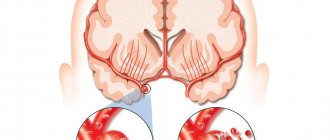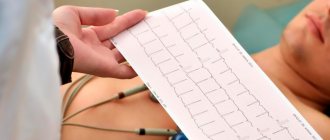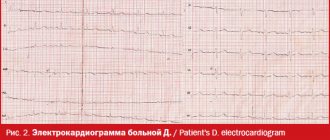Exercise therapy for congenital heart disease
Rehabilitation of children with congenital heart defects depends on the degree of dysfunction of the cardiovascular system. Along with pharmacological drugs and diet, exercise therapy, massage with oxygen therapy, and physiotherapy are used before and after surgery. The selection of PH exercises and determination of the load depend on the type of congenital heart disease, the degree of hemodynamic and respiratory disorders. Objectives of exercise therapy. improving the function of the cardiorespiratory system (due to increased muscle function, chest excursion, diaphragm movement, etc.), expanding the functional capacity of the lungs, increasing pulmonary ventilation; prevention of postoperative complications (pneumonia, atelectasis, pleural adhesions, etc.), prevention of postoperative muscle atrophy, prevention of the development of deformities, postural disorders, etc.
In the preoperative period, exercise therapy and general massage are performed, followed by inhalation of humidified oxygen. The first classes are aimed at teaching proper breathing (chest, diaphragmatic, with an emphasis on exhalation), coughing (coughing). Classes are conducted in a small group method in sitting and standing positions, and in case of circulatory problems - lying down. Duration 8-10 minutes. They include general developmental exercises, and pauses in the lesson are determined by the pulse. The complex includes 6-8 exercises.
Rehabilitation in the postoperative period. In the early postoperative period, exercise therapy includes breathing and general developmental exercises in the supine position to prevent complications and train the cardiorespiratory system and neuromuscular system. General massage is also provided.
Contraindications are the general serious condition of the patient, the risk of bleeding, emerging arrhythmias, a drop in blood pressure and its sharp fluctuations with a rapid pulse.
The selection of exercises, their repetition and intensity depend on the type of heart defect, the nature of the surgical intervention and the functional state of the cardiorespiratory system. Therapeutic gymnastics is carried out on the second or third day after surgery (mainly breathing exercises, inflating toys, balloons and exercises for the distal extremities, including coughing and massage). Gradually, depending on the patient’s condition and his tolerance to exercise therapy. the complex is being expanded. LH is carried out 2-3 times a day for 5-8 minutes. In case of pain when breathing, before LH exercises, patients undergo a general massage followed by inhalation of humidified oxygen.
In the following days, breathing exercises are supplemented with general developmental exercises, turning (with the help of a physical therapy methodologist) the child on his side. LH is performed lying or sitting in bed, and on the seventh or eighth day - sitting on a chair in the ward.
As the patient's condition improves, the motor mode is expanded by getting out of bed and walking around the ward. During this period, much attention is paid to the complete restoration of movements in the shoulder joint of the operated side, that is, correction of the patient’s posture.
Particular attention is paid to the coordination of general developmental exercises with breathing exercises. Exercises are performed at a slow and medium pace, breathing should be rhythmic, with an emphasis on long exhalation, duration 8-15 minutes, 2-3 times a day.
From the 10-12th postoperative day, exercise therapy is carried out in the hall in a group method with musical accompaniment, with a gradual increase in load. Classes are conducted in a sitting position on a chair and standing, lasting 15-20 minutes. They include walking along the corridor, along the stairs, in the summer with access to the hospital park.
The training period includes exercises with a gymnastic stick, medicine balls, dumbbells and against a gymnastic wall, as well as measured walking on the street (in a park, square). 3-5 days before discharge from the hospital, patients are taught a new complex of exercise therapy. which the child will do at home.
Sanatorium-resort treatment is carried out in local cardiological sanatoriums or in the fall in Crimea. Air-sunbathing, health path (dosed walking), walks along the seashore, exercise therapy, swimming, rowing, games on the seashore, etc. are shown. In winter - skiing, walking in the forest, park, as well as general UV irradiation.
An approximate complex of therapeutic exercises for heart disease; methodological development for physical education
Physiological basis of exercise
For diseases of the cardiovascular system (hypertension, heart defects, coronary disease, angina pectoris, rheumatic carditis, myocarditis, etc.), health-improving (adaptive) physical culture is used for the purpose of general strengthening of the body, improving the activity of the central nervous system, cardiovascular and respiratory systems, normalization of motor-vascular reflexes, vascular tone, improvement of metabolism. The selection of complexes depends on the stage of development of the disease and the age of those involved. The general requirement for the training methodology is a combination of general developmental (recreational) exercises and special (rehabilitation) exercises in combination with breathing exercises. General developmental exercises with a gradual increase in load (up to a pulse of 10-120 beats/min) help strengthen the heart muscles, improve blood supply (myocardium), and elasticity of the walls of blood vessels. With active contractions of skeletal muscles (compression of veins), venous circulation improves, the “muscle pump” intensifies, redox processes and metabolism intensify. During physical exercise, the pulse quickens, blood pressure rises, the amount of circulating blood increases, and capillary blood circulation increases.
With cardiovascular pathology, various functional changes are observed throughout the body, so the body’s response to all types of physical activity is weakened. However, the most traumatic exercises are those that involve large muscle mass of the body and perform high-power work. A significant oxygen supply is created in the body, and the cardiovascular system provides a significant increase in the minute volume of blood circulation. An example would be fast walking, running, skiing, etc. During short speed and strength exercises, no special oxygen demand is created, and minute blood volume does not increase significantly. Such exercises do not cause particular strain on the heart, but they increase vascular tone and may be unfavorable for hypertension. At the same time, physical exercises of a dynamic, cyclic nature, performed with low and moderate intensity, have a beneficial healing effect on the cardiovascular system as a whole. Intense, high-speed and strength exercises are not contraindicated, provided that small muscle groups participate in them (for example, only the muscles of the arms, legs, etc.) and provided that there is little reaction to them from the cardiovascular system. This is important to remember when developing certain professionally applied motor qualities related to strength and speed of movement in individual muscle groups. Such exercises have a beneficial effect in the presence of hypotension. In case of cardiovascular pathology, physical exercises with a complex biomechanical structure (gymnastics, acrobatic) performed with low intensity can be widely used. In case of vascular lesions, head-down positions (headstands, etc.) are contraindicated.
Physical exercise plays a big role in improving the health of a painfully altered cardiovascular system, the recovery capabilities of which are extremely high. Therefore, it is necessary to persistently use physical exercises, while avoiding overexertion. Signs of overstrain of the cardiovascular system can be: deterioration in general condition, decreased performance, increased heart rate, a drop or increase in blood pressure at rest, the occurrence of arrhythmia, an unfavorable reaction to stress during exercise (subjective complaints, shortness of breath, paleness, etc.) . In these cases, it is necessary to stop exercising or reduce the load and conduct additional medical examination. Signs of improvement in the state of the cardiovascular system during exercise are improvements in well-being, mood, increased general and physical performance, a decrease in the magnitude of the response of the cardiovascular system (pulse, blood pressure) in response to a standard load, stable pulse and blood pressure at rest. With a significant improvement in the response to physical activity, it is possible to transfer the student to classes in the preparatory group, but not earlier than 1-2 years after an acute rheumatic process or 1/2-1 year after an infectious disease. Subsequent transfer to the main group for cardiovascular diseases is most often impossible. Physical training for arterial hypertension (AH) As the experience of many authors shows, the most effective for the treatment of hypertension and the prevention of hypertension are physical exercises that promote the development of aerobic performance, i.e. general endurance. It is recommended to use cyclic exercises as aerobic exercises that develop general endurance. Repeatedly repeated acyclic and mixed exercises, which are performed in dynamic and static modes at a ratio of 90:10%. Physical activity should be intense. Thus, in the preparatory period of the annual cycle of physical exercises, loads should be given that cause an increase in heart rate to 130-140 beats/min, mainly to 160-165 beats/min. In this case, outdoor games and elements of sports games should be widely used. Physical exercise classes must include breathing exercises, relaxation exercises, and exercises to prevent postural disorders.
A set of physical exercises
All exercises should be performed freely, with full amplitude, without holding your breath or straining. It is effective to carry out therapeutic exercises in combination with massage of the head and “collar zone”. The complexes can be performed in a standing, sitting, lying position, with or without objects (ball, hoop, gymnastic stick), preferably with musical accompaniment. A sharp change in tempo and long-term static tension are not advisable.
An approximate complex of therapeutic exercises for hypertension
1. IP: sitting.
Breathing is controlled by the hands, full and deep. Repeat 6-8 times.
2. IP: main stand.
Hands up, one leg back - INHALE, return to IP - EXHALE. Repeat 3-4 times with each leg alternately.
3. IP: standing, legs slightly apart.
Sit down, leaning on a chair - EXHALE. Repeat 6-8 times.
4. IP: standing, arms clenched to the sides into a fist.
Bend your arms over your shoulders with slight tension - EXHALE. Repeat 10-20 times.
5. IP: hands on hips.
Exhale with your bent leg forward. Repeat 4-6 times with each leg.
6. IP: legs apart, arms to the sides.
Turn your torso to the right and left alternately - EXHALE. Repeat 4-6 times in each direction.
7. IP: sitting.
Deep breathing under the control of the hands. Repeat 4-8 times.
8. IP: standing, hands on hips.
Tilt the body to the right and left alternately. Hands slide along the body - EXHALE. Repeat 4-6 times in each direction.
9. IP: legs apart, hands to shoulders.
"Strikes" with your hands up alternately. Breathing is voluntary. Repeat 10-15 times with each hand.
10. IP: legs apart, hands on hips.
Slightly bend your torso forward - exhale. Return to IP. Repeat 4-8 times.
An approximate complex of therapeutic exercises for stage II hypertension
1. IP: sitting on a chair.
Hands to the sides - INHALE. IP - EXHALE. 4-5 times.
2. IP: the same.
Hands to shoulders, elbows to sides. Rotate the arms in the shoulder joints in different directions 12-16 times. Breathing is voluntary.
3. IP: sitting on a chair, legs straightened forward, heels on the floor. Rotate your feet 6-8 times in each direction. Breathing is voluntary.
4. IP: sitting on a chair.
Turn your torso to the right, right arm to the side, touch the back of the chair on the right with your left hand - EXHALE, IP - INHALE.
The same in the other direction. 4-6 times in each direction.
5. IP: the same.
The right leg is straightened forward, the left leg is bent at the knee joint. Change leg positions 8-12 times. Breathing is voluntary.
6. IP: sitting on the edge of a chair, leaning on the back, legs straightened forward, right hand on the chest, left hand on the stomach.
Diaphragmatic-thoracic breathing 3-4 times.
7. walking normally and with high knees for 1-1.5 minutes.
8. IP: main stand.
Relaxed shaking of the leg muscles, 2-3 times with each leg.
9. IP: the same. Rising to your feet, hands slide along the body to the armpits
depressions - inhale, I.P. -exhalation.
10. IP: standing, feet wider than shoulders, hands on the belt. Transfer the weight of the body to one leg, bending it at the knee joint, the same arm to the side - inhale, I.P. -exhalation. 4-6 times in each direction.
11. IP: the same. Tilt to the right, left hand behind your head - inhale. I.P. - exhale. 4-6 times in each direction.
12. IP: standing, holding the back of the chair with one hand. Swing your leg back and forth while relaxing your leg muscles, 5-8 times with each leg.
13. Walk 1-1.5 minutes.
14. IP: lying on your back with a high headboard, right hand on your chest, left hand on your stomach. Diaphragmatic-thoracic breathing 4-6 times.
15. IP: lying on your back. Bend your leg at the knee joint and pull your leg towards your stomach - exhale. I.P. - exhale. 8-10 times with each leg.
16. IP: the same. Bending the legs at the elbow joint, while simultaneously clenching the fingers into a fist and bending the feet - inhale, I.P. - exhale. 8-12 times.
17. IP: the same. Alternately raising your legs. 6-8 times with each leg, breathing randomly.
18. IP: the same, legs bent at the knee and hip joints with support from the feet. Relaxed shaking of the leg muscles, 20-30 seconds.
19. IP: lying on your back. Raising and moving your legs to the side, 6-8 times with each leg. Breathing is voluntary.
20. Repeat exercise 14.
21. IP: lying on your back. 1 - right hand on the belt, left to the shoulder, 2 - I.P., 3 - left hand on the belt, right to the shoulder, 4 - I.P., 5 - right hand on the belt, bend the left leg, 6 - I .P., 7 - left hand on the belt, bend the right leg, 8 - IP.. 4-5 times.
22. IP: the same. Close your eyes, relax the muscles of your right arm, then your left arm. 1-2 minutes.
Abstract: Exercise therapy for congenital heart defects
FEDERAL AGENCY FOR EDUCATION
____________________________________________________________________STATE EDUCATIONAL INSTITUTION
§6. Sample list of exercise therapy exercises
Conclusion
List of used literature
Introduction
Diseases of the cardiovascular system are currently the main cause of death and disability in economically developed countries. Every year, the frequency and severity of these diseases are steadily increasing; heart and vascular diseases are increasingly occurring at a young, creatively active age.
Congenital heart disease (CHD) is the general name for several heart defects caused by abnormalities in intrauterine development. The defect may be discovered at birth or may remain undetected for a number of years. Heart defects can be single birth defects or occur in complex combinations.
There are more than 35 known congenital heart defects in newborns, but fewer than ten are common. Every year in the United States, there are 8 births of babies with congenital heart disease for every 1,000 births.
Congenital heart disease is in second place in terms of frequency of occurrence after congenital defects of the nervous system. Congenital heart disease can be caused by genetic or environmental factors, but is usually a combination of both.
Heart diseases are associated with a violation of its basic functions - automaticity, conductivity, excitability and contractility. The most characteristic signs of circulatory failure are: a decrease in stroke and minute blood volumes; decreased arterial and increased venous pressure; increase in the amount of circulating blood; slowing down blood circulation; deterioration of oxygen supply to tissues.
The main symptoms of diseases of the cardiovascular system are: rapid heartbeat, shortness of breath, edema, cyanosis, heart rhythm disturbances, pain in the heart, hemoptysis, decreased body temperature, etc.
1. Classification of heart defects
There are congenital
and
acquired
heart defects.
Congenital heart defects are the result of impaired formation of the heart and large vessels in the first half of intrauterine development of the fetus, which is facilitated by intoxication and some diseases (for example, rubella) of the mother in the first half of pregnancy, the biological effect of ionizing radiation, and chronic fetal hypoxia. Some congenital heart defects are hereditary diseases. “Congenital” also includes those heart defects that are formed as a result of a delay in the final development of the child’s cardiovascular system in the first years of his life.
There are more than 100 different congenital heart defects. There are a lot of classifications, the latest classification used in Russia corresponds to the International Classification of Diseases and there are only 15 categories in it.
Congenital heart defects are conventionally divided into 2 types:
1. White
(pale, with left-right blood discharge, without mixing of arterial and venous blood), they include 4 groups:
► with enrichment of the pulmonary circulation (atrial and interventricular septal defect, etc.).
► with depletion of the pulmonary circulation (isolated pulmonary stenosis, etc.).
► with depletion of the systemic circulation (isolated aortic stenosis, coarctation of the aorta, etc.)
► without significant disruption of systemic hemodynamics (cardiac disposition, mesocardia; cardiac dystopia - cervical, thoracic, abdominal).
2. Blue
(with right-left discharge of blood, with mixing of arterial and venous blood), they include 2 groups:
►with enrichment of the pulmonary circulation (complete transposition
great vessels, Eisenmenger complex, etc.).
►with depletion of the pulmonary circulation (tetralogy of Fallot, Ebstein's anomaly, etc.).
In 2000, the International Nomenclature of Birth Defects was developed to create a common classification system.
A heart defect can be of the “blue” or “white” type, i.e. with or without cyanosis, depending on the group of the defect, the direction of blood discharge through the communication between the systemic and pulmonary circulation, the degree of increase in pressure in the pulmonary artery and the condition of the heart muscles. In addition to cyanosis (cyanosis) or pallor of the skin, shortness of breath, changes in the size and position of the heart, the presence of heart murmurs and changes in tones during auscultation, and retardation of children in physical development are characteristic. With a sharp enlargement of the right ventricle, a “heart hump” is observed - a keel-shaped protrusion of the middle part of the chest.
Acquired heart defects
- the result of heart disease after birth, most often rheumatic carditis, less often - atherosclerosis, septic endocarditis, syphilis. The most common defects are the left atrioventricular valve apparatus (the so-called mitral heart defects), then the aortic ones, and defects of other valves are less common.
§2.
Diagnosis and treatment
To determine the type of defect, special research methods are often necessary: angiocardnography, aortography, cardiac probing.
Data from laboratory and instrumental research methods are variable depending on the specific defect. Among the leading methods are:
— ECG
— plain radiography of the heart and contrast radiological techniques.
- echo-CG (the main technique - allows you to see the morphology of the defect and determine the functional state of the heart).
- Doppler echo-CG (allows you to determine the direction of blood flow).
Treatment of congenital heart disease can be divided into: surgical
(in most cases it is radical) and
therapeutic
(usually auxiliary).
Surgery. Depends on the phase of the vice.
In the first phase - emergency surgery. The expediency of these operations, however, is an ambiguous and purely individual issue.
In the second phase - surgery as planned (specific for a specific defect). The timing of implementation is a debatable issue and is constantly being revised (in the literature, the timing varies from intrauterine surgery to puberty, but is still more inclined towards early surgery).
In the third phase, surgery is not indicated.
§3.
Relationship between congenital heart defects and gender
A study of the relationship between congenital heart defects and gender was carried out in the early 70s of the 20th century based on data collected in several large cardiac surgery centers, as well as literature data. As a result of the analysis of 31,814 patients suffering from congenital heart defects, a clear connection between the type of defect and the gender of the patient was revealed (table).
Table - Gender ratio of patients with congenital heart defects
Physical culture in the prevention of cardiovascular diseases
Diseases of the cardiovascular system are currently the main cause of death and disability in economically developed countries. Every year, the frequency and severity of these diseases are steadily increasing; heart and vascular diseases are increasingly occurring at a young, creatively active age.
Diseases of the cardiovascular system include: myocardial dystrophy, myocarditis, endocarditis, heart defects, pericarditis, atherosclerosis, coronary heart disease (angina pectoris, myocardial infarction), hypertensive and hypotensive diseases, obliterating endarteritis, thrombophlebitis, varicose veins, etc. Special attention deserves coronary heart disease - a disease associated with acute or chronic dysfunction of the heart muscle due to a decrease in the supply of arterial blood to the myocardium. Varieties of ischemic disease are angina pectoris and myocardial infarction. Coronary disease occurs insidiously, often (in 35-40% of cases) without clinical symptoms, causing millions of cases of disability.
The spread of the disease is facilitated by a number of external and internal environmental factors (“risk factors”). From the group of socio-cultural factors, the most important are: consumption of high-calorie foods rich in saturated fats and cholesterol (overweight, obesity); smoking; “sedentary” (inactive) lifestyle; stressful conditions of modern life in large cities. Among the violations of bioimical and physiological regulatory mechanisms, the following are important: hypercholesterolemia, hypertriglycerodemia, a number of forms of hyperlipoproteinemia, impaired tolerance to carbohydrates, arterial hypertension, etc. Therefore, to strengthen the cardiovascular system, it is necessary to get rid of excess weight, eat less fatty foods and more vegetables and fruits, and also engage in physical exercise.
The influence of physical exercise on the state of the cardiovascular system of the human body.
Systematic physical training affects almost all organs and systems of the human body. What happens to the cardiovascular system under the influence of long-term physical training? In trained people, myocardial contractility significantly improves, central and peripheral blood circulation increases, efficiency increases, heart rate decreases not only at rest, but also under any load, up to maximum (this condition is called training bradycardia), systolic, or stroke, blood volume. Thanks to the increase in stroke volume of blood, the cardiovascular system of a trained person copes with increasing physical activity much easier than that of an untrained person, completely supplying blood to all the muscles of the body that take part in the load under high stress.
The heart weight of a trained person is greater than that of an untrained person. The heart volume of people engaged in physical labor is also much larger than the heart volume of an untrained person. The difference can reach several hundred cubic millimeters.
As a result of an increase in stroke volume in trained people, minute blood volume also increases relatively easily, which is possible due to myocardial hypertrophy caused by systematic training. In an untrained person, the increase in stroke volume of blood is mainly carried out due to an increase in the number of heart contractions. Sports cardiac hypertrophy is an extremely beneficial factor. At the same time, not only the number of muscle fibers increases, but also the cross-section and mass of each fiber, as well as the volume of the cell nucleus. With hypertrophy, metabolism in the myocardium improves. With systematic training, the absolute number of capillaries per unit surface area of skeletal muscle and heart muscle increases.
It has long been established that people who engage in systematic physical labor and exercise have wider heart vessels. If necessary, their coronary blood flow can be increased to a much greater extent than in physically inactive people. But, most importantly, thanks to the economical work of the heart, trained people spend less blood on the same work for the heart than untrained people.
Under the influence of systematic training, the body develops the ability to very economically and adequately redistribute blood to various organs. Let us remember the unified energy system of our country. Every minute, the central control panel receives information about the demand for electricity in various zones of the country. Computers instantly process incoming information and suggest a solution: increase the amount of energy in one area, leave it at the same level in another, reduce it in a third. It's the same in the body. With increasing muscular work, the bulk of the blood goes to the muscles of the body and to the heart muscle. Muscles that do not participate in work during exercise receive much less blood than they received at rest. Blood flow in internal organs (kidneys, liver, intestines) also decreases. Blood flow in the skin decreases. The only thing that doesn't change is the blood flow in the brain.
Thus, systematic physical training has an extremely beneficial effect on a person’s cardiovascular system and, in general, on his entire body. The effects of physical activity on the cardiovascular system are shown in table. 1.
Table 1
Differences in the state of the cardiovascular system of trained and untrained people.
| Indicators | Trained | Untrained |
| Anatomical parameters: | ||
| weight of the heart volume of the heart capillaries roundabout vessels of the heart | 350-500g. 900-1400ml large quantity | 250-300g 600-800ml small quantity |
| Physiological parameters: | ||
| resting pulse rate stroke volume resting minute blood volume systolic blood pressure resting coronary blood flow myocardial oxygen consumption at rest coronary reserve maximum minute blood volume | less than 60 beats/min 100ml More than 5 l/min Up to 120-130 mmHg 250ml/min 30ml/min Large 30-35 l/min | 70-90 beats/min 50-70 ml 3-5 l/min Up to 140-160 mmHg 250 ml/min 30 ml/min Small 20 l/min |
| Vascular condition: | ||
| elasticity of blood vessels in old age, presence of capillaries on the periphery | Elastic Large quantity | Lose elasticity Small amount |
| Disease susceptibility: | ||
| atherosclerosis angina pectoris myocardial infarction hypertension | Weak Weak Weak Weak | Expressed Expressed Expressed |
2. Selection and optimal dosage of physical. The healing mechanism of the effects of physical exercise in various cardiovascular diseases
For students with diseases of the cardiovascular system, a group method of training is recommended, preferably on the street, in a park or in a public garden, that is, physical education combined with hardening. The lesson is structured so that cyclic movements predominate (various types of walking and running, their combination, skiing, skating, breathing exercises). In winter, you need to make sure that students breathe through their nose. Relaxation exercises are shown. Exercises with holding your breath, straining, etc. are excluded.
During classes, it is necessary to monitor the student’s pulse, breathing, skin color and general condition. Morning exercises and hardening are very important. In the autumn-spring period - vitaminization (taking vitamins C and E is especially recommended). If possible, it is recommended to carry out ultraviolet radiation.
Exercise is a scientifically proven means of preventing cardiovascular diseases. Numerous studies have proven that a decrease in physical activity is a risk factor for the most common and severe diseases of the heart and blood vessels. Therefore, regular exercise reduces the likelihood of developing circulatory diseases.
Early treatment of cardiovascular diseases prevents their further development. Often, treatment does not require the use of medications; It is enough just to organize a healthy lifestyle: proper motor mode, a reasonable balance of work and rest, a rational, balanced diet, quitting smoking and alcohol, reducing emotional and mental stress. The most important component of health measures is therapeutic physical training, which promotes recovery or stops the further development of the disease.
To prevent diseases of the cardiovascular system, physical education is recommended for everyone, but especially for those who have risk factors. Various forms of training can be used. For the adult population, they are held in health groups based on the type of general physical training, and running clubs. Many healthy people exercise on their own. The method and dosage of physical activity are selected in accordance with the medical group to which the participants are assigned, age, gender, and level of physical fitness.
Organized and independent classes use gymnastic exercises, walking, running, swimming, skiing, rowing, games, and hiking.
Gymnastic exercises are easily dosed and have a targeted effect; they develop muscle strength, strengthen the ligamentous apparatus, improve joint mobility, improve coordination of movements, the ability to breathe properly and relax muscles. Gymnastic exercises have a varied effect on the central nervous system: most of them, especially exercises for coordination of movements and speed-strength exercises, excite, and exercises in muscle relaxation, breathing and movements performed very slowly, enhance inhibitory processes. Gymnastic exercises also have a pronounced effect on internal organs. For therapeutic purposes, they are selected in such a way as to specifically change certain functions of the body, promoting recovery. For example, in case of hypotension, strength, speed-strength and static exercises increase blood pressure, and in case of hypertension, exercises in muscle relaxation, breathing, for small muscle groups and some others help to reduce it.
Breathing exercises and muscle relaxation exercises have a general healing effect. Therefore, it is necessary to specially train students in the ability to control their breathing and relax their muscles.
Walking is a valuable and important means of therapeutic and health-improving physical culture. This is a natural and habitual form of muscle activity. While walking, many muscle groups of the torso, legs and arms are involved. When practicing independently, walking is the most accessible, easily dosed form of exercise.
For therapeutic purposes, walking is used at a slow pace (60-80 steps per minute, speed no more than 3 km/h), at an average pace (90-100 steps per minute, speed 3.5-4.5 km/h) and at fast (100-120 steps per minute, speed 5-6 km/h). A faster walking pace is not advisable. The length and frequency of steps during different periods of training depend on the tasks. In the beginning, a shorter stride and slower tempo are usually used, then the stride is longer and the tempo is increased. Walking at an average and fast pace gives a more pronounced effect than walking a long distance at a slow pace. Breathing while walking should be coordinated with the steps (exhalation is slightly longer than inhalation): first, inhale for 2 steps, and exhale for 3-4 steps, then inhale for 3-4 steps, and exhale for 5-6 steps.
At the beginning of health walking classes, light loads are used. Do I train students during this period? breathe correctly while walking. Walking pace is normal. Then they begin gradual, systematic training. First, increase the walking distance at the same pace; subsequently increase the pace, but reduce the distance by 10-20%; Then, as training increases, the distance and pace of walking are increased again.
The method of exercise therapy depends on the nature of the disease and the pathological changes caused by it, on the stage of the disease, the degree of circulatory failure, the state of the coronary blood supply, and the functional state of the patient.
In case of severe manifestations of the disease, severe heart failure or coronary circulation, exercise therapy classes are structured in such a way as to first of all have a therapeutic effect: to prevent possible complications - by improving peripheral circulation and respiration; help compensate for weakened heart function - due to the activation of extracardiac circulatory factors; improve trophic processes - by improving blood supply to the myocardium. For this, low-intensity physical exercises are used - for small muscle groups, performed at a slow pace, breathing exercises and muscle relaxation exercises.
When the patient's condition improves, physical exercises are used in a complex of rehabilitation measures to restore performance (although they continue to be used to implement therapeutic goals). Systematic training is of primary importance, i.e. during classes there is a gradual increase in physical activity, which is achieved: at first - through a greater number of repetitions; then - by increasing the amplitude and tempo of movements; further - through the use of more difficult physical exercises and starting positions. From low intensity exercises they move on to moderate and then maximum intensity exercises; from the initial positions lying and sitting - to a standing position. In the future, dynamic cyclic loads are used: walking, working on a bicycle ergometer, running, etc.
After completion of rehabilitation treatment and for chronic diseases, exercise therapy is used to maintain the achieved treatment results - to improve blood circulation and stimulate the functions of other organs and systems. Physical exercises and the dosage of physical activity are selected depending on the residual manifestations of the disease and the functional state of the patient. A variety of physical exercises are used (gymnastics, elements of sports, games), which are periodically replaced.
For effective treatment and rehabilitation of patients, the dosage of physical activity that is adequate to the patient’s condition is of great importance. To determine it, many factors must be taken into account: manifestations of the underlying disease and the degree of coronary insufficiency, level of physical performance, hemodynamic state, and the ability to perform household physical activity. Taking these factors into account, a division into four functional classes has been developed for patients with coronary heart disease; For each class, physical activity and training programs are regulated (for more details about functional classes, see section 3.5).
The method of exercise therapy for diseases of the cardiovascular system depends on the degree of circulatory failure.
1. In case of chronic heart failure of the third degree, exercise therapy is used only when circulatory failure is stabilized and during the period of intensive treatment when the patient’s condition improves. Therapeutic exercises are aimed at preventing possible complications, stimulating compensation and improving the patient’s mental state. Properly selected exercises do not hinder, but, on the contrary, facilitate the work of the heart, as they activate extracardiac circulatory factors. These exercises include active movements for small and medium muscle groups. Movements in large joints of the limbs are performed with incomplete amplitude, with a shortened lever, sometimes with the help of a physical therapy instructor or passively. Exercises for the trunk muscles are used only in the form of turns on the right side and slight elevation of the pelvis. Static breathing exercises are performed without deepening breathing.
The exercises are performed at a slow pace, from the starting position lying on your back (with the head of the chair raised). Number of repetitions: for large joints - 3-4 times, for small joints - 4-6 times.
2. In case of chronic heart failure of the second degree, exercise therapy is aimed at preventing possible complications: improving peripheral circulation; elimination of stagnation; improvement of metabolic processes in the myocardium; Providing a slight general tonic effect on the body, increasing the functions of all its systems (including the central nervous and endocrine).
2.1. In case of heart failure of degree IIB, the method of exercise therapy is basically similar to the method for failure of degree III - only the number of repetitions of movements in small joints increases (up to 8-10 times); breathing exercises are performed with lengthening and slight intensification of exhalation, which largely improves venous outflow and improves peripheral circulation. Exercises for the trunk muscles begin to be used, which are performed with incomplete amplitude, the number of repetitions is 3-4 times. Starting positions - lying and sitting.
2.2. In case of heart failure of degree IIA, the number of exercises for medium and large muscle groups of the limbs and torso is increased in exercise therapy. The amplitude of body movements gradually increases (but remains incomplete). All movements are performed in coordination with breathing. Special breathing exercises, static and dynamic, are performed with intensification and lengthening of exhalation. Movements in large joints are performed at a slow pace, number of repetitions - 4 - 6 times; in small joints - at an average pace, number of repetitions - 8 - 12 times. Starting positions - lying, sitting and standing. When the patient's condition improves, the task is to gradually adapt him to moderately increasing physical activity. Measured walking begins to be used; the distance gradually increases to several hundred meters; walking pace is slow. Gymnastic exercises become more complicated, the amplitude and tempo of movements increase. The number of repetitions of exercises for large muscle groups increases to 6-12 times.
3. In case of chronic heart failure of the first degree, the main task of exercise therapy is the adaptation of the cardiovascular system and the entire body of the patient to household and industrial physical activity. Therapeutic gymnastics classes include exercises for medium and large muscle groups, exercises with objects (gymnastic sticks, balls), with small weights (dumbbells, medicine balls weighing 1-1.5 kg) and with resistance; sedentary games, game tasks; various walking, short running at a slow pace. Movements that are complex in coordination are performed with full amplitude. The number of repetitions is 8-12 times. These exercises alternate with exercises for small muscle groups of the limbs and with breathing exercises. All basic starting positions apply: standing, sitting and lying down. In addition to therapeutic exercises, morning hygienic exercises and measured walking are used. The distance gradually increases from 300 - 500 m to 1 -1.5 km. Walking pace - up to 70 - 80 steps/min (speed - 50-60 m/min). In a compensated state (H0), the task of exercise therapy is to train the cardiovascular system and the body as a whole through gradually increasing physical activity.
3. Limitations and contraindications to the use of physical exercises for various cardiovascular diseases
Physical exercises as a means of treatment and rehabilitation are indicated for all diseases of the cardiovascular system. Contraindications are only temporary. Therapeutic exercise is contraindicated in the acute stage of the disease (myocarditis, endocarditis, angina pectoris and myocardial infarction during the period of frequent and intense attacks of pain in the heart, severe heart rhythm disturbances), with an increase in heart failure, and the addition of severe complications from other organs.
When the acute effects are relieved and the increase in heart failure stops, and the general condition improves, you should begin physical exercise. Exercise therapy is widely used for diseases of the circulatory system in the acute period during recovery and, in reality, as a factor in maintenance therapy.
Contraindications:
- acute phase of rheumatism, endo- and myocarditis;
- severe disturbances of the rhythm and conduction system of the heart;
- acute heart failure (pulse more than 104-108 beats/min, severe shortness of breath, pulmonary edema);
- stage III circulatory failure
4. A set of exercises for the prevention of diseases of the cardiovascular system
A set of exercises for cardiovascular diseases
- Starting position (i.p.) - lying on your back, arms bent at the elbows and resting on them. Bend your fingers and toes at the same time, then straighten. Repeat 4-6 times. The pace is slow. Breathing is free.
- I. p. - the same, arms along the body. Slide your palms along the body up to the armpits - inhale, return to i. p. - exhale. Repeat 3 times. The pace is slow.
- I. p. - the same, arms are bent at the elbows and rest on them. Simultaneously move your hands and feet towards you, then away from you. Repeat 4-6 times. The pace is slow. Breathing is free.
- I. p. - the same, hands down. Push your stomach out - inhale, lower it - exhale. Repeat 3 times. The pace is slow.
- I. p. - the same. Move your legs alternately by half feet for 6-8 counts towards yourself, bringing the bending in the knee and hip joints to a right angle, and also step half a foot away from you for 6-8 times. Repeat 2-4 times. The pace is slow. Breathing is free.
- I. p. - the same. Stretch your arms up above your head - inhale, lower - exhale. Repeat 3 times. The pace is slow.
- I. p. - the same. Bend your legs at the knees and hip joints and place your feet towards your buttocks, left hand on your waist. Place your knees to the right/grab the headboard or bedside table with your right hand and turn while exhaling onto your right side, remove your left hand from your belt, lie down for 1-2 minutes.
Transition to a sitting position with your legs down. From a lying position on the right side, legs bent at the knee and hip joints, left hand on the belt - simultaneously lowering your legs, with your right hand lean on the edge of the bed or grab it - inhale, take a sitting position with your legs lowered - exhale. The pace is average.
Move to a standing position. From a sitting position, with your hands on your belt or your right hand on your belt and your left hand resting on a chair or bedside table, tilt your torso forward, keeping your head straight, inhale and stand up as you exhale.
Transition from a standing position to a sitting position. Hands on the belt or the right hand on the belt, and the left one resting on the back of a chair or the edge of the table - tilt the torso forward by bending the hip joints and sit down as you exhale.
Walking without shortness of breath. Hands on the belt. Slowly raise one leg - exhale, lower it in front of you - inhale, do the same with the other leg, thus moving forward. Perform the exercise 6-8 times, gradually, over several days, increasing the “traveled” distance. After the normal breathing rhythm is restored, start walking like this - first 2 steps while exhaling, then 4, 6, 8 steps while exhaling, then proceed to normal walking.
Walking up stairs without shortness of breath. The left hand is on the belt or on the staircase railing, the right hand is lowered. Slowly, as you exhale, lower your right leg one step lower and place your left leg on it: inhale - during a pause, when both legs are on the same step, also while exhaling, lower your left leg and place your right leg on it. Climb up the stairs also while exhaling, alternately placing one foot on the step and placing the other on it. Inhale while both legs are on the same step. Walk down the stairs with a side step until you feel that you are breathing freely and can exhale and go down 4-6 steps at once. It is also recommended to climb up the Staircase while exhaling, not in a straight line, but diagonally, placing your feet not perpendicular to the step, but diagonally.
Conclusion
When performing physical exercises, the pulse quickens, blood pressure rises, the amount of circulating blood and the number of functioning capillaries in the skeletal muscles and myocardium increase.
Therapeutic exercises for diseases of the cardiovascular system, maximally activating the effect of extracardiac circulatory factors, contribute to the normalization of impaired functions.
Exercise therapy is widely used for diseases of the circulatory system in the acute period during recovery and, in reality, as a factor in maintenance therapy.
Exercise therapy is effective only if long-term, systematic classes are carried out with a gradual increase in load both in each of them and throughout the course. Both the coach and the student must know this in order to achieve appropriate results.
Exercise therapy technique for congenital and acquired heart defects
In the preoperative period (several weeks before surgery), the following exercise therapy tasks are solved:
— moderate mobilization of the reserves of the cardiorespiratory system;
— facilitating the work of the heart due to the inclusion of extracardiac circulatory factors;
- combating the manifestations of neurosis, anxiety, building the patient’s confidence in the successful outcome of the operation;
— mastering exercises in the early postoperative period (learning diaphragmatic breathing and techniques for painless coughing and lifting).
Depending on the general condition of the patient, the results of the examination and the indicators of functional tests for constructing a method of exercise therapy, patients with congenital heart defects are divided into three groups: A, B and C.
Group A
– patients with minor complaints of mild shortness of breath and fatigue after physical activity. Hemodynamic parameters – without pronounced disturbances. Blood discharge (open aortic duct, atrial and interventricular septal defects) occurs “from left to right,” i.e. excess blood enters the pulmonary circulation. The results of functional tests are regarded as favorable.
Group B
– patients in a state of moderate severity with complaints of weakness, shortness of breath, palpitations and fatigue. The examination indicates hypertension in the pulmonary circulation. These patients may experience: tetralogy of Fallot, various forms of disturbance of the great vessels, a single ventricle, etc. The results of functional tests are acceptable.
Group B
– patients in serious condition with complaints of shortness of breath with little physical exertion and at rest, fatigue, palpitations, interruptions in cardiac function, frequent headaches. This includes patients with stenosis, coartation of the aorta and other congenital defects in which the flow of blood into the systemic circulation is difficult. The results of functional tests are satisfactory.
In the preoperative period, classes with these groups of patients are carried out according to the following scheme (Table 1).
Table 1
Distribution of patients with congenital heart defects into groups for PH exercises (according to E.I. Yankelevich, 1995)








